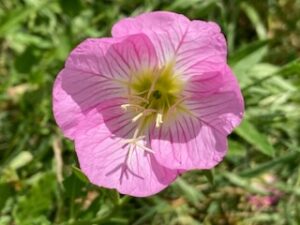

by Lydia Holley April 24, 2023
While traveling this weekend, I enjoyed seeing numerous wildflowers along the Texas highways. The roads were lined with Indian paintbrush, bluebonnets, Indian blankets, spiderwort, blue-eyed grass, larkspur, and a childhood favorite of mine: buttercups.
Oenothera speciosa is usually called pink ladies, evening primrose, or pink buttercups, but when I was growing up, we just called them buttercups. We would put the pollen-filled anthers to our noses and rub, leaving a yellow stain behind. Now, I am not certain if that was good or bad for allergies, but it gave us hours of enjoyment and entertainment.
Ever since then, I have loved seeing these delicate-looking blooms in the spring. A Texas native, buttercups both spread through their rhizomes and increase by seeding. If you add it to your garden, treat it as a groundcover and give it plenty of room. It can spread to almost six feet in diameter and its rhizomes can sink over a foot down in the ground. That makes it drought tolerant, although it will die if its soil becomes completely dry. It also hates standing water and appreciates well-draining soil.
It makes a great addition to meadow-style plantings or wildflower plantings. A perennial, it will return from year to year to give you plenty of smiles whether or not you rub its pollen on your nose. In fact, the bees will probably appreciate you leaving it for them. Butterflies and hummingbirds will also visit these flowers. Later on, birds will come to eat the seeds. Thankfully, deer do not seem to like it. When it spreads too large, it is easily divided.
To bloom well, it needs full sun. It can flower for a long time, and the petals’ almost-white hue will turn rosier as they age. Enjoy them while they last. When the weather gets too hot, it will go dormant.
For more information, call 903-675-6130, email hendersonCMGA@gmail.com.
Follow us on Facebook: https://www.facebook.com/HCmastergardener.